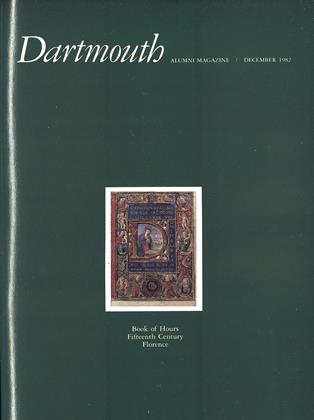Foreign Students at Dartmouth
The College's first foreign student was Louis Vincent, from Lorette in Canada, who after graduating in 1781 "returned to his tribe as a teacher." There were only five people in the Class of 1781 and so he was 20% of it, undoubtedly the high point for percentages of foreign students in a class in the history of the College. For the most recent ten years the percentage of undergraduates has remained rather stable, between two and three, but if the current members of the executive of the I.S.A. (International Students Association) are as persuasive as they hope to be, that figure will move up noticeably, bringing Dartmouth closer to the figures for those universities in the Ivy League which have a more active recruiting program for foreign students. And helping to fulfill the Dickey Endowment's objectives in promoting understanding among all nations.
There are approximately 100 foreigners enrolled as undergraduates today (about a third of them from Canada) and about 25 as graduate students. (Getting an exact figure is complicated by uncertainties in definitions: some Americans have lived abroad for so much of their lives and been educated tor so long in the vernacular that they are more "foreign" when they get*to Dartmouth than some of the people with foreign passports who have been to English-speaking boarding schools since, childhood; and some students coming from American addresses have in fact arrived in this country only a very short time before reaching college age.) .'The group of 125 ± as a whole include people from about forty countries, covering all five continents. They undoubtedly add a great deal to the richness of student life, and a number of American undergraduates join the I.S.A. in order to benefit more directly from the stimulus of being with contemporaries who view the world from standpoints very different from their own.
In a few countries Ghana and Mexico are the best examples there seem to be networks of contacts which lead to a fairly steady flow of good applicants; but in most cases applications come from self-starters (more often than not from students in capital cities who have access to U.S. embassy information services.) Quite a few current students had their interest in an American education generated by the recruiters who came from other colleges and universities, and then discovered more about Dartmouth for themselves as they weighed the options.
There seems to be little doubt that few things more directly reveal ignorance about the rest of the world or more pointedly challenge easy assumptions about the way it works than prolonged one-to-one encounters with people from abroad, and most of the foreign students have the satisfaction of knowing that they are foreign .teachers too. Most of them would like the chance to gain more of that kind of satisfaction from their time in Hanover; all of them seem to take it in stride. And those who are most active would certainly welcome the opportunity to do whatever they can to make their particular piece of leaven somewhat larger, so that it may have a better chance of "leavening the whole lump," as that famous traveller, St Paul/ Sao Paulo/San Pablo, so straightforwardly put it.
The editor gratefully acknowledges the assistance 'of the advisor tothe I.S.A., Linda Garceau, who is writing an ALA. thesis on foreign students at Dartmouth.
The International Students' Association Executive, and friends
Credits This publication was designed by Richard Hess and edited by Peter Smith Adrian Bouchard took all the photographs of President Dickey and those of the 1929 Honorary Degree recipients; Gary Cahn TU '83 the photograph of Professor Quinn; Tim Geithner '83 those of the November 5 ceremonies and the one of the China Foreign Study Program; Nancy Wasserman '77 the one of Professors Huke and Luis, and that of the International Students Association Executive.
 View Full Issue
View Full Issue
More From This Issue
-
 Feature
FeatureOn Building Community
December 1982 By Mary Ellen Donovan -
 Feature
FeatureWhere They Hang Their Hats
December 1982 By Steve Farnsworth and Jean Korelitz -
 Feature
FeatureWindows on a World
December 1982 By Shelby Grantham -
 Article
ArticleDartmouth in the World
December 1982 -
 Article
ArticleRound the Girdled Earth...
December 1982 -
 Article
ArticleTHE DICKEY ENDOWMENT
December 1982







